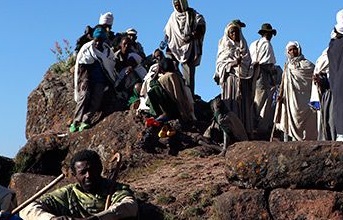Ethiopian Empire
The Ethiopian Empire, also known as Abyssinia (derived from the Arabic al-Habash), was a kingdom that spanned a geographical area in the current states of Eritrea and Ethiopia. It began with the establishment of the Solomonic dynasty from approximately 1270 and lasted until 1974, when the ruling Solomonic dynasty was overthrown in a coup d'йtat by the Derg.
 The territory of present-day Eritrea was occupied by Italy in 1890 and became Italian Eritrea. Following the British occupation of Egypt in 1882, Ethiopia and Liberia were the only two African nations to remain independent during the Scramble for Africa by the European imperial powers in the late 19th century. Ethiopia remained independent after defeating Italians during the First Italo-Ethiopian War. Later, after the Second Italo-Ethiopian War, the Italian Empire occupied Ethiopia briefly for five years and established the Italian East Africa colony in the region. The Italians were later driven out with the help of the British army. The country was one of the founding members of the United Nations in 1945.
The territory of present-day Eritrea was occupied by Italy in 1890 and became Italian Eritrea. Following the British occupation of Egypt in 1882, Ethiopia and Liberia were the only two African nations to remain independent during the Scramble for Africa by the European imperial powers in the late 19th century. Ethiopia remained independent after defeating Italians during the First Italo-Ethiopian War. Later, after the Second Italo-Ethiopian War, the Italian Empire occupied Ethiopia briefly for five years and established the Italian East Africa colony in the region. The Italians were later driven out with the help of the British army. The country was one of the founding members of the United Nations in 1945.By 1974, Ethiopia was one of only three countries in the world to have the title of Emperor for its head of state, together with Japan and Iran under the Pahlavi dynasty. It was the second-to-last country in Africa to use the title of Emperor; the only one later was the Central African Empire, which was implemented between 1976 and 1979 by Emperor Bokassa I.



